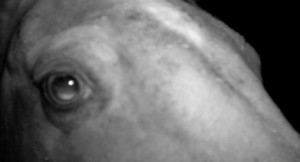
“One-to-One:Close Quarters”, speaker, part of panel session chaired by Nigel Rothfels, Society for Literature, Science, and the Arts, Notre Dame University, Indiana, October 2013
“Horses: In House, In Hand, and In Person”, Chair: Nigel Rothfels
Session 2, Lee Deigaard, Angela Hofstetter, and Erica Tom.
Session 1: Gala Argent, Richard Nash, Karen Knarr
“The contributors to these two panels are thinking about new, perhaps postnatural, ways to talk about the physical, emotional, and intellectual embodiedness of horses and how those aspects of the creatures must be part of our interactions with them and thinking about them. Coming from a range of fields–including archaeology, literary studies, art practice, American studies, and veterinary practice, the panelists will discuss how intimate living with horses, engaging them as complex living entities and being open to new configurations of human/horse relationships, opens up our thoughts and work about horses.”
Lee Deigaard: “One-to-One: Close Quarters”
My artwork portrays animal protagonists and the landscape we mutually inhabit. Longterm ongoing video and photographic projects explore what it is to interact closely with a horse, one-to-one, without halter or rein, for the primary purposes of companionship and nonverbal communication. My series of nocturnal portraits in the horse pasture investigates proprioceptive awareness, the darkness highlighting both a sense of intimacy and of otherness, and rely in their making on the horse’s voluntary collaboration. My photographic series “Horse Lips” considers
close physical proximity to the horse’s mouth and nose, the highly sensitive, investigative, and communicative equine corollaries to the human hand. “Dirty/Pure” engages online voyeurism via YouTube commentary on woman-horse interactions. “Steady Star”, a video animation installation includes recordings of the sounds of a sleeping horse and the pine shavings of a horse’s bed. “Villanelle” and “Pastorale”, long-form videos and large-scale projections rely on the associative, narrative-building rhythms of fragmentary moments-in the barn, in the pasture, in the woods.
I am interested in ways of seeing and being seen: the meeting and crossing of gazes, looking through and seeing [what is] past. The mind’s eye, the forensics of memory, recollection, and projection, the existential filters of species and tree branches and deep darkness.
Eyes are windows, windows are viewfinders, boundaries, frames, and lenses. Object, subject, free will, trespass are illuminated in the hidden moments between moments. The plasticity of identity, of identification, shares borders-human and horse, light and dark, body and space.